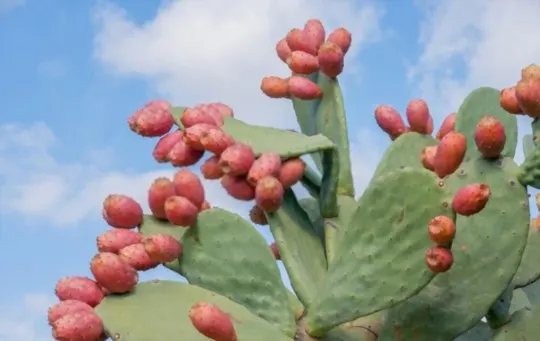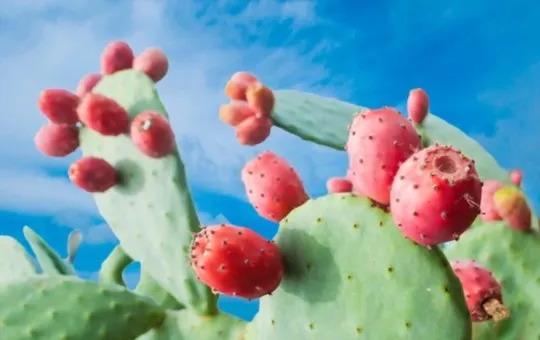So you’ve seen it in the store or on social media: prickly pear – a peculiar cactus-like succulent with its vibrant pink hue, but have you ever given thought to what this unique fruit tastes like?
From curious foodies looking to try something new and exciting, to health enthusiasts intrigued by the health benefits of this special plant, many are wondering “What does prickly pear taste like?”
Now don’t fret!
We will be exploring in detail all about the tangy flavor and texture profile of this fascinating fruit.
Let’s get started with exploring what makes these wild fruits so special.
What is Prickly Pear?

Prickly pear is a cactus fruit, commonly found in Mexico, the southwestern United States, and other arid regions of the world.
This fruit is oval-shaped and covered in spines, and the inside is sweet and juicy, with a flavor profile that is often compared to a cross between bubblegum and watermelon.
While prickly pear is delicious on its own, it’s often used to make drinks, such as juices, teas, and margaritas.
The flavor of prickly pear pairs well with other fruits, such as lime, lemon, and grapefruit.
When eating prickly pear, be sure to carefully remove the spines and tough outer skin before consuming.
What Does Prickly Pear Taste Like?

Prickly pear is a fruit that comes from a cactus plant of the Opuntia genus.
It is commonly found in Latin American, Mexican, and Southwestern US cuisine.
The fruit has a sweet and mild flavor, similar to a cross between a watermelon and a pear, with a slightly tangy and earthy taste.
The texture of the fruit can vary depending on the cultivar, but it is typically soft and juicy with numerous small edible seeds.
Prickly pears can be eaten raw, as a snack or in salads, or cooked in sauces, jellies, or jams.
They are also used to make drinks like agua fresca, cocktails, and even beer.
If you’re looking to try a unique and flavorful fruit, prickly pear is definitely worth a taste.
How to Eat and Cook Prickly Pear?

Prickly pear is a fruit that comes from the cactus plant, and it’s a popular ingredient in many dishes and beverages that people enjoy around the world.
The fruit has a sweet, juicy taste similar to watermelon, with a hint of tanginess that also makes it perfect for savory dishes.
If you’re looking to incorporate prickly pear into your cooking or try it as a fresh fruit, here are some tips on how to eat it:
- Choose a ripe prickly pear that is red or purple in color and slightly soft to the touch.
- Using a sharp kitchen knife, cut off the top and bottom ends of the fruit.
- Make a shallow cut from top to bottom just through the skin and peel it back gently.
- Remove any remaining spines.
- Slice the fruit into rounds or cubes and enjoy fresh or use it in your favorite recipes.
Pro-tip: If you’re using prickly pear in recipes, it’s best to cook it first to remove the seeds and skin.
Simply boil the fruit for a few minutes, then let it cool before slicing and using as desired.
Health Benefits of Prickly Pear

Prickly pear, also known as cactus fruit, is a nutrient-dense fruit with a distinct taste and numerous health benefits.
Prickly pear has a mild flavor similar to a cross between watermelon and bubblegum.
It is often described as sweet and slightly tart, with a texture that’s a combination of a pear and a watermelon.
Here are some of the health benefits of prickly pear:
- Boosts Immunity: Prickly pear is rich in vitamins, minerals, and antioxidants that help boost the immune system.
- Lowers Blood Sugar: Prickly pear has a low glycemic index, making it an excellent fruit option for those with diabetes.
- Promotes Digestive Health: The fiber and water content in prickly pear help promote digestive health and prevent constipation.
- Anti-inflammatory Properties: Prickly pear contains anti-inflammatory compounds that can help reduce inflammation in the body.
In conclusion, adding prickly pear to your diet can provide a range of health benefits and is an exciting addition to your daily meals.
Where to Buy Prickly Pear and How to Store It?
Prickly pear is a fruit that comes from the Opuntia cactus, native to Mexico and southern USA.
It has a sweet, mildly acidic taste and a texture similar to watermelon.
The fruit is found at specialty food stores, farmer’s markets, and online vendors all year round.
When buying prickly pear, look for fruit that is plump, firm, and brightly colored with no wrinkles, soft spots or blemishes.
To store the fruit, place it in a plastic bag and store it in the refrigerator for up to 4 days.
Prickly pear can be eaten raw, grilled or boiled, juiced, or made into jams, candies, and cocktails.
To prepare, simply cut off the top and bottom of the fruit, make a slit down the peel, and peel it off the flesh.
Pro tip: Wear gloves and use tongs when handling prickly pear as the spines on the fruit can be painful.
Conclusion
In conclusion, prickly pear is a type of cactus fruit that is native to the Americas and is now grown worldwide.
It has a unique flavor and texture that is described as a cross between watermelon, cucumber, and kiwi, with a slightly sweet taste and a crunchy texture.
Prickly pear can be eaten raw or used in a variety of dishes, such as salads, jams, and drinks, and is packed with nutrients like antioxidants, fiber, and vitamins.
Prickly pear is also used in traditional medicine to treat a range of ailments including diabetes, high cholesterol, and hangovers.
Overall, prickly pear is a delicious and healthy fruit that is worth incorporating into your diet.

What Does Prickly Pear Taste Like? Does it Taste Good?
Ingredients
- Prickly pear
- Ingredients from your selected recipes
Instructions
- Select ingredients that work well together.
- Use a recipe or method that will enhance their natural taste.
- Taste and adjust the recipe as needed to achieve the desired flavor.

Carrie is a food writer and editor with more than 15 years of experience. She has worked for some of the biggest names in the food industry, including Bon Appétit, Food & Wine, and Martha Stewart Living.
As the Editor in Chief of IntroChicago.com, Carrie oversees all of the content on the site. She also manages the team of contributing writers and editors, who help to create delicious recipes, helpful tips, and informative articles that you’ll find on the site.
A native of the Chicago area, Carrie is passionate about all things food. She loves trying new restaurants and experimenting with new recipes in her kitchen. She’s also a graduate of the Culinary Institute of America, so she knows a thing or two about food!
